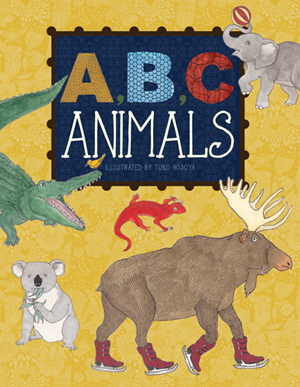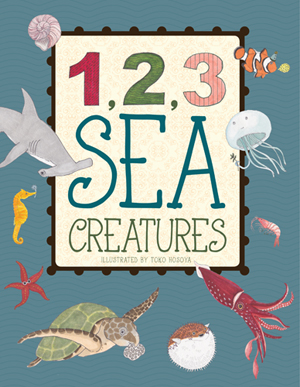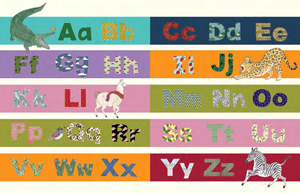| ________________
CM . . .
. Volume XXII Number 40. . . .June 17, 2016
excerpt:
The two books share a number of design commonalities, in particular, the detailed, stylized floral backgrounds for each page’s focal creature. With the exception of U’s Unicorn, the remaining animals in A, B, C Animals are a mixture of the more common, such as C’s Cat, P’s Pig and S’s Squirrel, along with the more unusual, such as I’s Indri, N’s Newt and X’s X-ray fish. Some of the animals, like H’s Hedgehog, Q’s Quail, V’s Vole and Z’s Zebra, are illustrated as they might appear if seen in their natural habitat, but many of the animals have something unusual added to them. For instance, O’s Owl is shown holding what appears to be a coffee cup, a possible explanation for why it can stay awake all night. But why does I’s Indri have a phone, J’s Jaguar a crown, M’s Moose ice skates, R’s Racoon a trumpet and T’s Turtle a pocket watch? Hosoya doesn’t provide any answers, but instead she allows the reader and the read-to to suggest and arrive at their own answers. The text for each letter of the alphabet in A, B, C Animals is limited to a single word, that being the name of the animal that is illustrated, with the initial letter being presented in upper case. Readers need to stop and examine the illustrations or patterns contained within the outline of each upper case letter. Again, Hosoya wordlessly invites readers to answer why? Why is the G in Giraffe filled with clouds, why is the M in Moose filled with green and white triangles, why are there what appear to be slices of pizza in Raccoon’s R, or why is there a mountain in Yak’s Y? A, B, C Animals’s last pair of facing pages present the entire alphabet, but now the letters are shown in both their upper and lower case forms. From the title, 1, 2, 3 Sea Creatures, I anticipated that on the first page I would perhaps find a single fish and on the second possibly something like two turtles. Such was not the case, and for the numbers from one through 10, I never found more than one of any sea creature. Then what was I to count? Hosoya’s brief text provides the answer. For example, with the number 2, the text reads “Two walrus tusks”, with the accompanying illustration revealing a toothbrush-holding walrus. Many of the things that are to be counted in this section of the book are actually additions to the sea creature, and so “6 Six rings” sees an eel-like creature swimming through six hula hoops while ”10 Ten shrimp shoes” reveals a single shrimp, its 10 legs outfitted with boots. Readers turning the page after the ten shrimp shoes encounter the text: “One to ten is fun! Here’s five BIG numbers, then we’re done.” The next four pages invite readers to count 20 hammerhead sharks, 40 crabs, 60 sting rays, 80 pufferfish and 100 seahorses. In the following five double-page spreads, Hosoya’s text calls for readers to find a certain number of a specific sea creature - “Now find four starfish that look like this.” An illustration of a starfish is offered as a visual prompt. The penultimate double-page spread provides the numbers from 1-30 as well as the names and images of 30 different sea creatures. The closing spread has the 30 sea creatures together beneath the water and challenges readers to name as many of them as they can. In each book, a pocket on the inside of the back cover contains a 20" x 16" full-colour poster. That for A, B, C Animals, which duplicates the book’s last page, repeats the animals that had been used to represent the letters of the alphabet, but this time the letters are rendered in both their upper and lower case forms without any words completing them. Consequently, any youngster who doesn’t know that the cat-like animal beside Jj in the poster is a jaguar will have to seek out its name in the book. The illustrations in the poster for 1, 2, 3 Sea Creatures, which also duplicate the book’s last page, frequently differ from those that appear in the book’s 1-10 section. On the poster, what is to be counted is the number of sea creatures that represent a particular number whereas, as was described above, that was not the case within the book. On the poster, for the number three, the child is to count three swordfish, but in the book, there is only one swordfish. However, impaled on its “sword” are three doughnuts, and the text reads “3 Three doughnuts.” ABC and counting books are often correctly associated with a child’s earliest years, but the more challenging contents of A, B, C Animals and 1, 2, 3 Sea Creatures would suggest a slightly older target audience of four to seven-year-olds. The embossed animals on the books’ covers deliver a tactile treat before readers discover the visual delights inside. Highly Recommended. Dave Jenkinson, CM’s editor, lives in Winnipeg, MB.
To comment on this title or this review, send mail to cm@umanitoba.ca.
Copyright © the Manitoba Library Association. Reproduction for personal use is permitted only if this copyright notice is maintained. Any
other reproduction is prohibited without permission.
CM Home |
Next Review |
Table of Contents for This Issue -June 17, 2016
| Back Issues | Search | CM Archive
| Profiles Archive |


 According to promotional material accompanying A, B, C Animals and 1, 2, 3 Sea Creatures, Toko Hosoya is a recent graduate of the Etobicoke School of the Arts and is presently studying illustration at OCOD University in Toronto. Perhaps there’s an unspoken “rule” or rite of passage requirement that calls for all new illustrators to take on the challenge of creating a fresh approach to the ABC and counting book genres. Should that be the case, then Hosoya has succeeded admirably.
According to promotional material accompanying A, B, C Animals and 1, 2, 3 Sea Creatures, Toko Hosoya is a recent graduate of the Etobicoke School of the Arts and is presently studying illustration at OCOD University in Toronto. Perhaps there’s an unspoken “rule” or rite of passage requirement that calls for all new illustrators to take on the challenge of creating a fresh approach to the ABC and counting book genres. Should that be the case, then Hosoya has succeeded admirably.